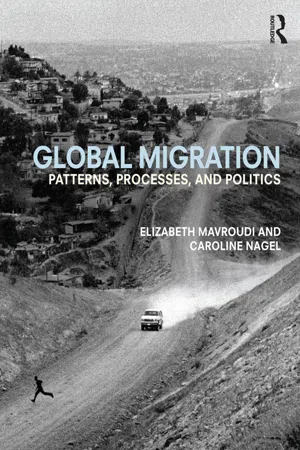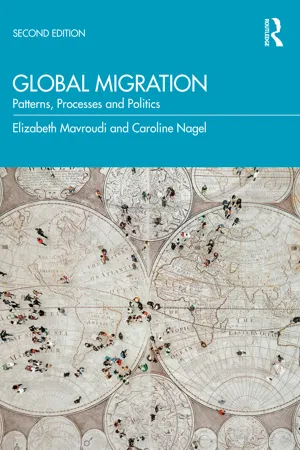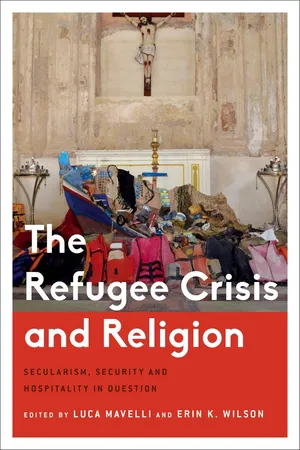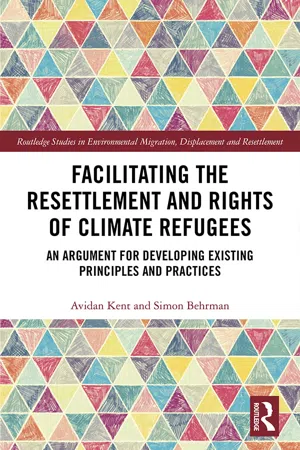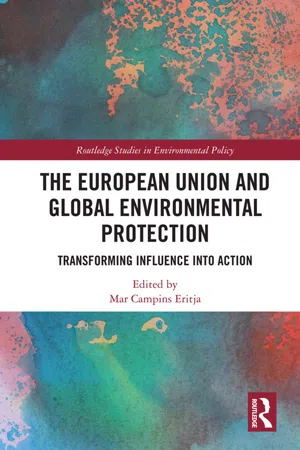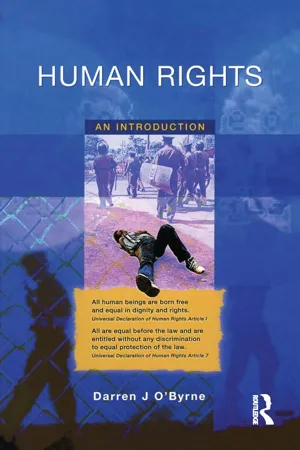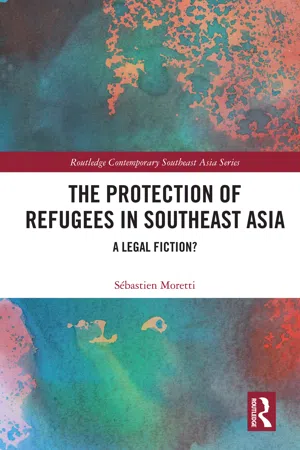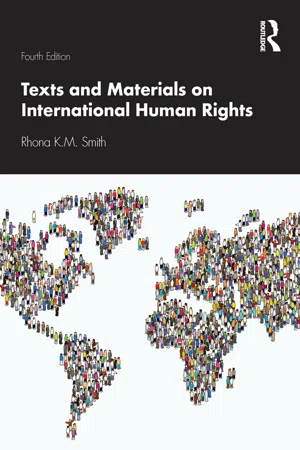Geography
Refugees
Refugees are individuals who have been forced to flee their home countries due to persecution, war, or violence. They seek safety and protection in another country. The United Nations High Commissioner for Refugees (UNHCR) is responsible for coordinating international efforts to assist and protect refugees. Refugee movements have significant geographic implications, including impacts on host countries and the spatial distribution of displaced populations.
Written by Perlego with AI-assistance
Related key terms
10 Key excerpts on "Refugees"
- eBook - ePub
Global Migration
Patterns, processes, and politics
- Elizabeth Mavroudi, Caroline Nagel(Authors)
- 2016(Publication Date)
- Routledge(Publisher)
The previous chapters have dealt primarily with labour migrations, which we have connected to complex assemblages of employer demands, state policies, and individual and household decision-making, among other factors. In this chapter, we turn to migrations that are tied less clearly to wages and labour markets than to episodes of political upheaval, warfare, and violence. We can speak of these as forced, or involuntary, migrations. It is important to recognize from the outset that in the real world there is no clear dividing line between ‘voluntary’ and ‘involuntary’ migrations, or between economic and political migrations. Many economic migrations involve some element of compulsion—most obviously in the case of slavery and trafficking, but also in the case of ‘ordinary’ migrations where difficult local circumstances make migration necessary for household survival. By the same token, many of those fleeing political instability and violence may also be in search of economic opportunity and may choose their destinations accordingly. All migrations, in this sense, are produced through some combination of economic and political factors and through interactions between human agency and structural forces beyond the immediate control of ordinary people. Yet, it is also apparent that some migrations involve more human agency than others and are motivated more obviously by the immediate threat of violence and conflict than by economic interests. Thus, we can begin to speak in more specialized terms about forced migrations and the specific politics that these migrations produce.Plate 5.1 Syrian boy on a truck Source: Andrew McConnell/PanosThis chapter will examine the phenomenon of forced migration with a focus on Refugees. Many contemporary discussions of Refugees rely on the United Nations definition of a refugee as any individual who,owing to a well-grounded fear of being persecuted for reasons of race, religion, nationality, membership of a particular social group or political opinion, is outside of his country of nationality and is unable or, owing to such fear, is unwilling to avail himself of the protection of that country.As we explain later in this chapter, the UN definition is narrow and individualistic and seems at odds with the reality of large-scale displacement caused by civil conflict and war. We prefer a broader definition, such as that offered by Gibney (2004 , 7), who describes Refugees as ‘those people in need of a new state of residence, either temporarily or permanently’ because returning home or remaining where they are would ‘seriously jeopardize their physical security or vital subsistence needs’.While all migrants are perceived as problematic in a world organized around territorially bounded nation-states, Refugees are particularly troublesome from the perspective of recipient countries. The world of Refugees, some suggest, is almost a separate ‘limbo world’ (Walzer, 1970, cited in Malkki, 1995 - eBook - ePub
Governing Climate Induced Migration and Displacement
IGO Expansion and Global Policy Implications
- Andrea C. Simonelli, Kenneth A. Loparo(Authors)
- 2016(Publication Date)
- Palgrave Macmillan(Publisher)
It also set the legal principle of non-refoulement, which states that no refugee should be returned to any country where he/she is likely to face persecution, ill treatment, or torture. States have endorsed this principle, but have looked to define its limits. Others have extended protections, such as the Organization of African Union (1969) and the Cartagena Declaration (1984) treaties, which add circumstances such as events of external aggression, occupation, foreign domination, and events seriously disturbing the public order (Goodwin-Gil and McAdam, 2007). While the term “refugee” has a specific legal meaning, it is often still used as a general concept which can vary in meaning. Shacknove (1985) argues that Refugees should be seen as persons whose basic needs are unprotected by their country of origin and who have no remaining recourse than to seek international restitution for their dilemma. This definition would open up the label to many more people around the globe, including those displaced by climate change.Refugee studies focus on many of the legal issues with refugee processing, who can and cannot be considered an asylum seeker, issues of resettlement, reconstruction, peace building, aid, and protracted crises. The most contentious issue may be bureaucratic labeling, which can blur the lines between Refugees and other groups of forced migrants. Many academics and policy makers use language that implies refugeehood, such as “environmental refugee”, “economic refugee”, and similar terms. This language confounds the important distinctions between those forced to move because of these issues and the fact that even though they may need assistance, there is no legal precedent for individual nations to have to provide it. Politically, this bureaucratic label can also be used as a tool for marginalization (Zetter, 1991). All migration labels are weighed against the Convention; however, more labels have been created as the world has sought to restrict its protections (Zetter, 2007).Environmental migrationDevelopment induced displacement and disaster induced displacement are common and widely discussed forms of forced migration. Both are generally considered part of the larger sphere of environmental migrants. There is general agreement on three causes of environmental migrants: natural disasters and environmental or industrial accidents, planned or unplanned relocation due to development, and health-related effects due to inadequate resources to maintain life (Cardy, 1994). This definition has been influenced by El-Hinnawi (1985), who specified that the first category encompassed temporary displacement because of earthquakes, cyclones, or environmental/industrial accidents; the second includes those who are permanently displaced due to man-made changes to a habitat, such as development projects; the third are those who migrate temporarily or permanently because their original habitat can no longer support them, such as due to drought and crop failure. Direct and indirect displacement will likely span all categories. As more frequent and increasingly stronger hurricanes, cyclones, and drought occur, environmental migrants from group one will increase. If a government decides to erect improved sea walls or divert water into drought areas, an increase of migrants in group two will be possible. Finally, if people begin to move due to the inability to sustain their lives and livelihoods, they will fall into group three. This includes those living on coastlines which are being lost to rising seas or agricultural lands that have been ravaged by desertification. These examples are certainly not exhaustive, but offer a glimpse as to the way that climate change can exacerbate known groups of environmental migrants and complicate current labels. Dun and Gemenne (2008) argue for a better definition of environmental migration in that it is often difficult to isolate environmental factors from other drivers of migration. Environmental factors are challenging to differentiate from other drivers, as they are often underlying and not necessarily seen by those affected by them in the same way that they are viewed by those studying the event. The environmental damage of human habitats can initiate a chain of events which affects peoples’ lives and livelihoods. The driver is not specifically the environment, but its effects. People do not migrate simply because of drought, but because they cannot produce food anymore. They do not move because of a cyclone, but because the cyclone has eradicated the industry which provided the community with jobs. - eBook - ePub
Global Migration
Patterns, Processes and Politics
- Elizabeth Mavroudi, Caroline Nagel(Authors)
- 2023(Publication Date)
- Routledge(Publisher)
We prefer a broader definition, such as that offered by Gibney (2004, 7), which describes Refugees as ‘those people in need of a new state of residence, either temporarily or permanently’ because returning home or remaining where they are would ‘seriously jeopardize their physical security or vital subsistence needs’. When we refer to Refugees and ‘displaced people’ in this chapter, we have this broader definition in mind. Still, we cannot dispense with the UN definition entirely, given its centrality to international law and national-level refugee policymaking. Rather than taking the official definition at face value, we attempt throughout this chapter to understand how it shapes ideas about the vulnerability and deservingness of certain groups of people and how it informs political responses to conflict-related mobility (Bakewell, 2008). While all migrants are perceived as problematic in a world organized around territorially bounded nation-states, Refugees are seen as particularly troublesome from the perspective of recipient countries. Refugees, some suggest, exist in almost a separate ‘limbo world’ (Walzer, 1970, cited in Malkki, 1995, 9) that exists on the outside of the ‘normal’, legitimate world of territorially bounded nations. Lacking the protection of their own government, Refugees cross borders, often without a formal invitation from their ‘hosts’; in this way, they are rendered fundamentally out of place, if not quite stateless. While at times treated with compassion, they are more often met with wariness or even outright hostility by their hosts, especially if they are seen to be a political liability for ruling elites. It is for this reason that states, while voicing their commitments to humanitarian assistance, seek to control the movement of Refugees. This chapter begins by explaining the phenomenon of refugee flows - eBook - ePub
The Refugee Crisis and Religion
Secularism, Security and Hospitality in Question
- Luca Mavelli, Erin Wilson(Authors)
- 2016(Publication Date)
- Rowman & Littlefield International(Publisher)
http://www.unhcr.org/pages/49c3646c125.html ). This distinction has significant biopolitical implications as it constructs Refugees as subjects in need – as people who deserve protection and who need to be treated humanely – and migrants as commodified labor whose acceptance is subordinated to the economic needs of the host country.Albeit seemingly uncontroversial, this distinction is problematic, largely because it is a primarily bureaucratic distinction aimed at providing easy categories through which to determine whether an individual is in need/deserving of protection or not. Yet, the lived realities of migration are extremely blurred on the ground and do not easily conform to these categories, rendering them untenable. Individual experiences of persecution are not the only factors that contribute to people living in daily fear of their lives and forcing them to flee in search of safety. Betts (2013) has called this ‘Survival Migration’. He argues that the provisions of the Refugee Convention, with their emphasis on the violation and abuse of human rights, are a reflection of the post-Second World War political climate, when understandings of displacement were informed by the individual persecution witnessed as part of the Holocaust and the onset of the ideological conflict of the Cold War. As he emphasizes, the nature of displacement has transformed dramatically since then. Betts argues instead that dealing with asylum and refuge requests requires a focus on the deprivation of rights, not just their violation (Betts 2013). This would enable the recognition of other dynamics beyond individual persecution that threaten people’s lives in the contemporary context, including mass indiscriminate violence, endemic poverty, climate change and political instability. Gabriel’s story, as transcribed in the chapter by Vicki Squire, attests to the complex factors that contribute to a person undertaking a journey of migration, and that the line between ‘forced’ and ‘unforced’ is rarely easy to define in practice. As Jørgen Carling observes: - eBook - ePub
Facilitating the Resettlement and Rights of Climate Refugees
An Argument for Developing Existing Principles and Practices
- Avidan Kent, Simon Behrman(Authors)
- 2018(Publication Date)
- Routledge(Publisher)
No-one, for example, who leaves their home for a holiday, or simply to take up a job offer elsewhere comes within the category. In so far as there is a connecting thread between the many different framings of the concept, it is to do with people who have had to leave their normal habitats to seek protection from some sort of harm or threat. And on that simple criterion, why would people having to flee floods, drought, repeated crop failures and other severe disruptions to the means of life, and to life itself, not qualify? Why not add a new category to go alongside Palestine Refugees, war Refugees, political Refugees: climate Refugees? To sum up the previous points, the concept of the refugee has changed over time, often responding to geo-political changes that have forced us to reconceptualise the notion of a refugee and the meaning of asylum, but that the central element has been consistently one of protection for those suffering, or in fear of, serious harm. Climate change arguably represents one of the major shifts in our geo-political reality now and for the foreseeable future. Those displaced as a result of climate change are worthy of protection, not least because they are victims of forms of structural violence affecting the poorest and most vulnerable. 38 It is no accident that the people currently at the sharp end of climate change are from some of the poorest parts of the world – Bangladesh, Pacific Islands, the Sahel. By contrast, the people of California, a state that has experienced a drought for a number of years, are relatively immune to its effects. As the IPCC noted in 2014, ‘populations that lack the resources for planned migration experience higher exposure to extreme weather events’. 39 And in circumstances where even the best adaptation strategies or the greatest wealth can no longer stem the tides, literally or figuratively, it will always be the poorest who will have the least means to move elsewhere and to reconstitute their lives - eBook - ePub
The European Union and Global Environmental Protection
Transforming Influence into Action
- Mar Campins Eritja, Mar Campins Eritja(Authors)
- 2020(Publication Date)
- Routledge(Publisher)
IOM (2007) holds that several factors have an influence on migratory contexts and that it is sometimes difficult to separate the triggers of climate change from political, social, and economic aspects, among others. However, the environment and climate change are determining factors that play a notable and increasingly decisive role in human mobility. The growth in the frequency and intensity of sudden and gradual climate-related natural disasters implies a greater likelihood of humanitarian emergencies that will result in population displacements. The adverse consequences of warming, climate variability, and other effects of climate change on living conditions, public health, food security, and water availability can exacerbate pre-existing vulnerabilities and encourage migration. Rising sea levels can lead to the uninhabitability of coastal areas and low-lying islands. The scarcity of natural resources generates tensions and eventually conflicts, and, in turn, forced migration.Despite the evidence that environmental changes, natural disasters, and degradation are drivers of migration, there is as of yet no internationally accepted definition of persons on the move due to environmental reasons. The lack of recognition and, therefore, of protection is partly due to the absence at the international level of the term “environmental refugee”.9 Indeed, the 1951 Geneva Convention Relating to the Status of Refugees10 (1951 Refugee Convention) defines a “refugee” as a person who has crossed an international border “owing to well-founded fear of being persecuted for reasons of race, religion, nationality, membership of a particular social group or political opinion”. However, to condition the protection of migrants solely on the existence of political causes is to simplify realities that are, in most cases, very complex.11Undoubtedly, environmental migration is not only a controversial issue, but also one that requires debate now because it has ceased to be a likelihood and is now tangible. Indeed, there are people who have already had to emigrate because they have run out of resources and/or become landless because of environmental disasters. The 2017 Atlantic hurricane season demonstrates the extent of the risk of forced migration in the Caribbean; three of the season’s major hurricanes, Harvey, Irma, and Maria, forced approximately three million people to move in a single month.12 - eBook - ePub
- Francesca Rosignoli(Author)
- 2022(Publication Date)
- Routledge(Publisher)
“The people – scores of millions of people – who are using the land in disregard of its capabilities are Displaced Persons in a much more serious sense than the few hundred thousand in European refugee camps.They are displaced in the ecological sense.They can feed and clothe themselves, and supply food, fibers, charcoal, and wood to cities only by destroying the land on which they live and resources associated with it… .Scores of millions of them must be moved – down the eroding slopes, out of the degenerating forests, off the overgrazed ranges – if they are not to drag ever lower the living standards of their respective countries – and the world. The solution of the problem of European DPs is simple in comparison with that of the ecological DPs” (Vogt, 1949, p. 107). 1948 Ecological Refugees Lester Brown/World Watch Institute “As human and livestock populations retreat before the expanding desert, these ecological Refugees create even greater pressure on new fringe areas, exacerbate the processes of land degradation, and trigger a self-reinforcing negative cycle of overcrowding and overgrazing in successive areas. When the inevitable drought sets in, as one did in the early seventies, this deteriorating situation is brought to a disastrous climax for the humans who perish by the hundreds of thousands, for livestock, which die in even greater numbers, and for productive land, which is destroyed” (Brown et al., 1976, p. 39). 1976 Economic Refugees Kathleen Newland “Throughout history people have been driven from their homes by wars or ecological catastrophes … The voluntarism of these migrants’ moves may be qualified by desperation and lack of alternatives, yet the force that expels them is usually not the force of arms but rather the force of circumstance. They are, in a sense, economic Refugees” (Newland, 1979, p. 5). 1981 Environmental Refugees Essam El-Hinnawi Those people “who have been forced to leave their traditional habitat, temporarily or permanently, because of a marked environmental disruption (natural and/or triggered by people) that jeopardized their existence and/or seriously affected the quality of their life” (El-Hinnawi, 1985, p. 4). 1985 Environmental migrant Astri Suhrke and Annamaria Visentin Environmental migrant is a person who “makes a voluntary, rational decision to leave a region as the situation gradually worsens there. In that decision, environmental deterioration may be only one factor among others” (Suhrke & Visentin, 1991, p. 73). - eBook - ePub
Human Rights
An Introduction
- Darren O'Byrne(Author)
- 2014(Publication Date)
- Routledge(Publisher)
4 The standard — but possibly outdated — definition of a refugee is taken from the 1951 United Nations Convention Relating to the Status of Refugees:any person who, owing to a well-founded fear of being persecuted for reasons of race, religion, nationality, membership of a particular social group or political opinion, is outside the country of his nationality and is unable or owing to such fear, is unwilling to avail himself of the protection of that country… or unable or… unwilling to return to it5There is little doubt that the refugee crisis is one of the mobt dramatic concerns of the contemporary world. The number of Refugees has risen from under 3 million in 1986 to 11.7 million legally recognised Refugees in the world today.6 The actual figure probably exceeds 20 million. There are some 5 million officially recognised Refugees living in Western Europe alone. Internally displaced persons around the world — those forced to flee their homes who remain within their own country — amount to an estimated further 25 to 30 million. In total, one person in every 115 alive today is a refugee or displaced person.7 It is estimated that around 52 per cent of the world's Refugees are children.The rights of Refugees are protected, theoretically, by the United Nations High Commissioner for Refugees (UNHCR). In its mission statement, the UNHCR claims that its primary purpose is to ‘safeguard the rights and well-being of Refugees’, and to ‘ensure that everyone can exercise the right to seek asylum and find safe refuge in another state, and to return home voluntarily’. These efforts, it claims, are guided by the 1951 UN Refugee Convention, and by its 1967 Protocol. The UNHCR was established by the UN — 36 votes for, 5 against, 11 abstentions -in 1949, to operate for a period of three years from 1951 to oversee the immediate refugee crisis. A previously established UN organ, the International Refugee Organization, had been largely unable to solve the crisis through resettlement, and was eventually closed down in 1952. The UNHCR was intended to take a more proactive stance. In terms of its work in this respect, the UNHCR seeks to discourage displacement by ‘encouraging states and other institutions to create conditions which are conducive to the protection of human rights and the peaceful resolution of conflicts’. The UNHCR also acts in partnership with governments, super-governmental organisations, and NGOs to assist in the returning and reintegration of Refugees into their countries of origin. As well as Refugees and asylum-seekers recognised as such by the various statutes and covenants, the UNHCR deals with cases pertaining to ‘returnees’ (repatriated Refugees who remain a cause for concern for a period of time after return), war victims, those of undetermined nationality, and the internally displaced. - eBook - ePub
The Protection of Refugees in Southeast Asia
A Legal Fiction?
- Sébastien Moretti(Author)
- 2022(Publication Date)
- Routledge(Publisher)
1.1. This new definition is inspired from the definition contained in the Refugee Convention with the focus on persecution, yet with a few changes such as the introduction of ‘ethnicity’ as a ground for persecution – like in the Bangkok Principles – and the absence of a reference to the fact that a refugee may be ‘unable’ to avail himself or herself of the protection of his or her country of origin. UNHCR ’s role is emphasized, since a ‘refugee’ is also someone UNHCR has registered and to whom it has granted some form of status. It is not clear from the language of this presidential regulation whether someone recognized by UNHCR as a refugee based on the broader refugee definition, that is, someone fleeing armed conflict and generalized violence, would be recognized as a refugee under this definition considering that the focus of the first part of the sentence is on the fear of persecution. This is arguably so, however, since in practice the Indonesian Government leaves UNHCR to deal with the registration and the determination of the refugee status of all persons claiming asylum in the country based on its mandate, and thus on the basis of the broader definition including both people fleeing persecution and people fleeing armed conflict and generalized violence. 5.4.2. Distinguishing persons in need of international protection from migrants in Thailand During the Indochinese refugee crisis, Thailand accepted a large number of Indochinese Refugees, whatever the causes of their flight, provided they would be taken care of by the international community and resettled in the shortest possible time - Rhona K.M. Smith(Author)
- 2019(Publication Date)
- Routledge(Publisher)
There are specific provisions for minors, family members and for those seeking asylum who hold valid residence documentation for one or more Member States. Europe is often a destination country for Refugees, many of whom eventually settle in the region as they are unable to return home. However, other countries experience mass movements of persons when sudden catastrophes engulf a country, whether man-made (e.g. conflict) or natural (e.g. floods). Obtaining detailed statistical information on the numbers of Refugees and other displaced persons is a very difficult task for the Office of the High Commissioner and NGOs working in the field. The process of documentation is necessarily detailed. Obviously securing emergency humanitarian assistance is the priority.Full statistical information on numbers of Refugees and others of concern are published regularly by the Office of the High Commissioner of Refugees and available online (www.unhcr.org ). The information provided shows the numbers of asylum claims, the numbers of Refugees and the numbers of returned Refugees (i.e. those able to return to their home country).13.2.1 ChildrenChildren may arrive either with their parents/guardians, or unaccompanied seeking refuge. As Chapter 9
Index pages curate the most relevant extracts from our library of academic textbooks. They’ve been created using an in-house natural language model (NLM), each adding context and meaning to key research topics.
